Greenhouse gas reduction goals of major countries and recent changes in circumstances
Global policy trends and reduction goals of major countries
- Since the Kyoto Protocol of 1997, greenhouse gas reduction action plans have been prepared and implemented on a global scale to resolve climate change crises
- The mandatory target agreed upon in Kyoto by 38 Annex I countries around the globe was an average reduction of carbon emissions by 5.2% from 1990 levels by the year 2012.
Individual countries specified their own target reductions.
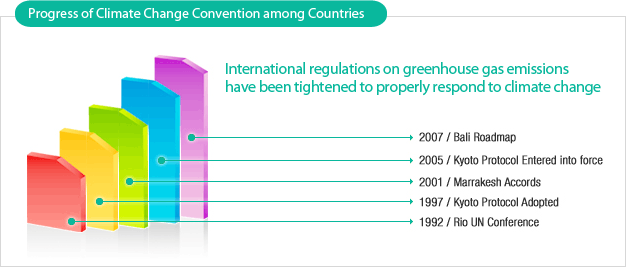
Mid-term reduction goals and measures of major countries
?
| Country |
Brief Description |

EU |
- 20% reduction from 1990 levels by 2020
- Effectuated EU climate-energy legislative package containing relevant directives in April 2009
- Introduced and implemented European Union Emissions Trading Scheme (EU ETS) in 2005
- Introduced regulation on automobile GHG emissions in 2009
|

UK |
- Adopted the world’s first Climate Change Act and specified reduction target in December 2008
- Target reduction of 34% from 1990 levels by 2020
|

US |
- January 2009 plan to invest $150 billion in new and renewable energy industry for next 10 years
- Waxman-Markey Bill requiring a 17% reduction of carbon emissions from 2005 levels by 2020 passed by House of Representative in June 2009
|

Japan |
- Announced a Cool Earth 50 plan in May 2007 for establishment of a low carbon society
- Announced J Recovery Plan in April 2009 incorporating a revolutionary low carbon strategy
- Announced target reduction in June 2009 of 15% from 2005 levels by 2020
|
Korea
- Although the 9th biggest greenhouse gas emitter in the world, Korea is not among the 38 Annex I countries with a mandatory commitment to reduce under the Kyoto Protocol
- The amount of greenhouse gas released by Korea almost doubled during the 1990s due to phenomenal economic growth based on manufacturing
- Korea is ranked first among OECD members for the rate of increase in emissions
- This is attributed to the energy-intensive industrial and societal structures that are highly dependent on fossil fuels
※ Ratio of energy-intensive industries (steel, cement, petrochemicals) (%, ‘06) Korea (8.0), Japan(4.6), US(3.1)
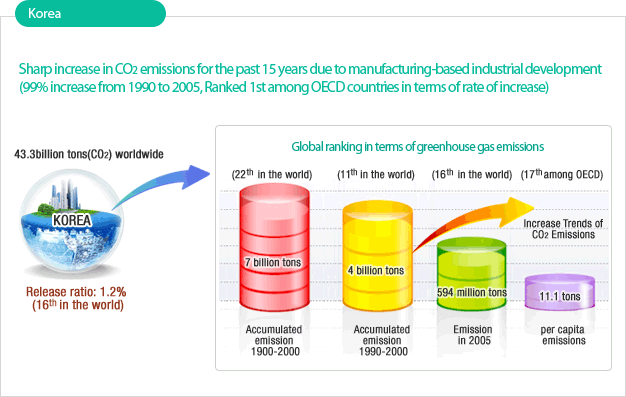
Role of Korea in climate change negotiations
- Korea is not an Annex I Country under the Kyoto Protocol but the international community demands that it be included in the category of developed countries and take different reduction actions from those of China and India.
- ※ The EU demands developed countries, including OECD members, reduce emissions by 25% from 1990 levels by 2020 and that developing countries cut levels by 15~30% compared to Business As Usual (BAU)
- As an advanced developing country, Korea has voluntarily presented a reduction target and demonstrated global leadership by proposing a Nationally Appropriate Mitigation Action (NAMA) Registry that developing counties are able to engage in
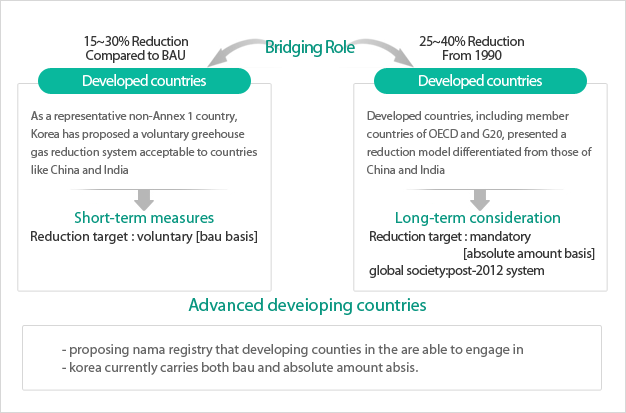
Mid-term(2020) Reduvtion Targer
Methodology of Setting Reduction Target
The reduction target scenario is based on systematic analysis of several variables, including prospective amount
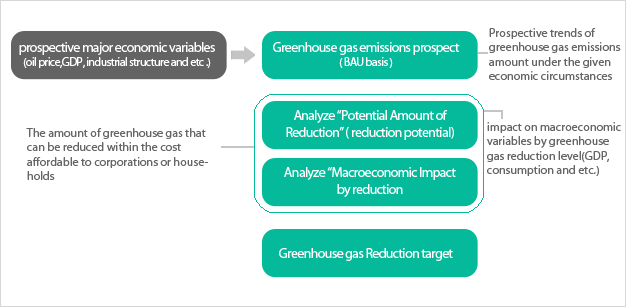
Mid-term Reduction Target Scenario
- Three different scenarios are presented with an analysis of potential reduction amount and requirements of the international community taken into account (August 4, ’09)
- Draft ① 21%, Draft② 27%, Draft ③ 30% reduction below prospective estimated amount of emissions
(based on BAU)
(① +8%, ② Freeze, ③ – 4% compared to 2005 emissions)
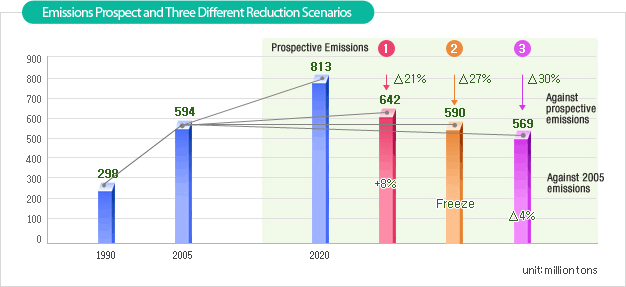
Mid-term Reduction Target Scenario
|
Reduction target |
Reduction policy selection criteria |
Major reduction measures(Each item includes policy measures of previous scenario) |
| Against BAU |
Based on ’05 emissions |
| 1 |
△ 21% |
+ 8% |
Introduce cost-efficient technologies and policies |
- Green building/housing
- Tightened demand-side regulation such as distribution of high efficiency facilities
- Reshape transportation system with low-carbon scheme
- Expand the portion of new and renewable energy and nuclear energy
- Implement Smart Grid
|
| 2 |
△ 27% |
Freeze |
Introduce cost-efficient technologies and policies |
- Eliminate fluorine gases with high global warming index(GWI)
- Expand the distribution of bio-fuels
- Partial introduction of CS
|
| 3 |
△ 30% |
△ 4% |
Maximum reduction amount for developing countries |
- Distribute next-generation green car (electric car, fuel cell vehicle etc)
- Expand the distribution of high-efficiency household appliances
- Implement rigorous demand-side regulations
|
- Financing: The government is planning to invest a total of 107 trillion won for the implementation of green growth between 2009 and 2013 with the focus on the greenhouse gas reduction target. It is estimated this will create an additional effect on production inducement worth 182 to 206 trillion won
- Nominal GDP is estimated to decrease by 0.29%~0.49% due to greenhouse gas reduction policies but the real overall GDP is expected to rebound above the nominal GDP by elevating production and creating more jobs through green industries based on expanded R&D investment* Per household share to be borne is estimated to be somewhere between 130,000 and 220,000 won
- More positive outcomes are expected by introducing the Emission Trading Scheme or imposing carbon taxes, incomes from which can be used to reduce income taxes and R&D investments
- Quality of life is expected to be enhanced along with public health through low-carbon society policies with high-efficiency transportation vehicles, environment-friendly constructions and so on.
National Reduction Target Finalized November 17, 2009
The cabinet approved the plan to set the reduction target at 30% on this date
Future Action Plans
- Establish reduction target by sector and implement target action plans (2010~)
- Perform follow-up actions to establish detailed reduction target by sector and industry
- Conduct precise analysis of potential reduction amount by sector and industry and establish/ manage short- and mid-term (three to five years) reduction target
- Prepare detailed implementation plans such as finance and policies to meet short-term reduction target
- Analyze and manage policy-based performance to meet reduction target
- Establish infrastructure for periodic and systematic analysis and target management
- Set up a permanent independent research system for sustained revision and development










